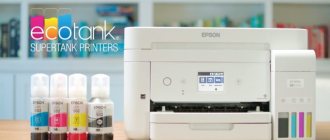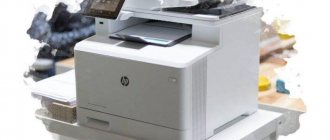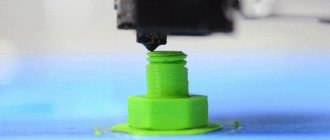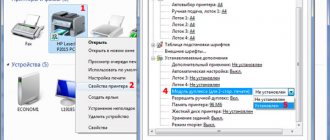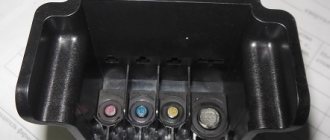Every day, a large number of users are faced with the need to print photos. For this purpose, devices are used that use various methods of recording information on a given surface. A sublimation printer, or, as it is also called, a heat-sublimation printer, is just one such device that allows you to print photographs in high resolution without loss of quality.
Is high quality always justified? Probably not, but if you need to work with bright colors and high resolution, then the sublimation process will be preferable. So, let's look at this device in more detail.
How it works
What is a sublimation printer? His work is based on the principle of sublimation, in other words, the process when a substance passes from one (solid) state to another (gaseous), bypassing the middle phase (liquid).
In all cases, there is a special element inside the sublimation machine that increases the temperature to start the process itself. A film is stretched between such an element and the thermal paper, more reminiscent of ordinary food-grade polyethylene. This film itself contains three primary colors (dye): cyan, magenta and yellow. When a command to start printing is received from the PC, the film quickly heats up, and after reaching the required temperature, the liquid from the dye evaporates. Photo paper has fairly large pores, which expand even more when heated, resulting in the application of a cloud of dust consisting of paint quickly and evenly. The paper catches all the paint material, absorbing it into itself. As soon as the printing process is completed, the pores immediately decrease in size, reliably fixing and storing information on their surface.
The printing process consists of three parts; the paint is not applied all at once, it happens in stages. Today, many models can play it safe and complete the printing with an additional, fourth run before issuing a photograph. This is necessary to create a protective film on the surface of the paper, which will additionally preserve the image from direct exposure to ultraviolet rays and other environmental influences (dirt and fingerprints).
Almost all heat-sublimation devices use a three- or four-pass printing system, but the operating principle itself is the same in all models.
Thanks to thermal sublimation, you can achieve the highest quality photographs. Such disadvantages as rasterization and banding are not found on such devices due to a different operating principle, unlike inkjet printers, where the quality of the final product often suffers greatly. Another design advantage of thermal sublimation printing is a uniform layer of ink on the surface of photo paper. There are no boundaries between an ink drop and blank paper due to the absence of drops themselves. The sublimation process does not apply ink to the surface, but places paints under the top paper layer, behind which the image acquires additional protective properties and becomes resistant to fading.
There is special software that allows you to make the finest temperature settings. Using this software, you can achieve unique image clarity and contrast, as well as display halftones and shades in a variety of gradations. Another clear advantage is the possibility of applying almost indistinguishable light tones, a high degree of intensity of dark tones and black.
What materials can be sublimation printed on?
This type of printer is notable for the fact that it can print on almost any surface. The user has a choice of the following materials.
- Paper. The sublimation method can be used to print photographs, business cards, booklets, menus and much more.
- Glass and ceramics. If desired, you can apply any pattern or design to a mug, bowl and other utensils.
- Metal. A sublimation printer can be used to print on souvenirs such as ashtrays, flasks, and spoons.
- Stone. If desired, the device can be used to apply inscriptions and portraits to monuments.
- Textile. Using a sublimation printer, you can easily decorate a boring T-shirt or sneakers with bright prints. You can also decorate the curtains in the room.
- Plastic. Image printing is available on trays, plastic dishes and any other items made of this material.
T-shirt printing
But there are also products on which printing with such a device is not recommended. Ink does not adhere well to leather, wood and natural fabrics.
And for printing on glass and stone, these surfaces must first be prepared for applying paint. To do this, they are treated with polymer compounds. You can print on natural fabrics only if you first apply a special primer to them, ensuring dense absorption of the paint.
Materials
To operate a sublimation printer, you will need appropriate consumables and additional components.
- Banners and postcards, leaflets and photographs are printed on paper
- on fabric when images are transferred to home textiles and clothing items.
- Souvenirs can have metal, stone and glass surfaces.
- They transfer images using sublimation to ceramic objects and dishes .
What is needed for printing
First of all, to apply the drawing you will need special paper and ink. In cases where printing on other materials is required, a heat press may be additionally required . In this case, the principle of operation of the device changes slightly. First you need to transfer the image onto paper, and then use a heat press to transfer it to another material. The process occurs under the influence of high temperatures and pressure.
Depending on your use cases, you can choose one of the following heat presses.
- Flat. Such a device will be required for printing on flat ceramics or glass.
- Baseball. Heat press, which is necessary for printing on caps, baseball caps and other headwear.
- For dishes. This device is used for printing on plates and glasses.
Combined heat press for sublimation printing
If we compare ordinary and sublimation paper, the difference is that the second has a special ultra-thin coating. It ensures that the paint adheres to the material and is applied most effectively.
Sublimation printers use a special solid ink that turns into a gas when heated. You need to select them based on the device model and the material on which the image will be applied.
Inkjet printer and sublimation printer: comparison
Inkjet and sublimation printers not only have different designs, but also many other differences regarding print quality, speed and other parameters. For some of them, sublimation printers are superior to inkjet printers, but in some respects they are inferior to them. Advantages of a sublimation printer compared to an inkjet printer:
- The quality and durability of the resulting images. Pictures made on a printer for sublimation printing are clear and colorful, resistant to moisture and sunlight, and do not fade. They have high quality color rendering. Raster dots are not visible. Drawings printed on an inkjet printer are less durable, fade faster and have different raster patterns. The image quality and color rendition are much worse; the transitions in colors and tones are not smooth enough.
- Ease of use. Sublimation printers are more convenient to use, since most models have displays that display operating information about the printing process.
- Range of applications. Sublimation equipment has almost no limitations - it is possible to transfer images to any surface and product. Inkjet printers can only print on flat media (paper, discs, plastic cards).
Disadvantages of a sublimation printer compared to an inkjet printer:
- Print speed is slower.
- The price of consumables is higher.
- When sublimation ink evaporates, an unpleasant odor appears, so the room in which such a printer operates needs to be regularly ventilated.
Both inkjet and sublimation printers can have technical problems. In the first, the print head quite often becomes clogged and needs to be cleaned or replaced. And the latter are sensitive to dust. If it gets inside, vertical scratches may appear on the images.
What kind of paper is used in the devices
The sublimation printer allows you to use different sizes of paper. The most commonly used formats for printing are A2, A3, A4. However, you can also work with smaller scales (A5, A6) or larger ones (A0, A1). To plot images on large-format sheets, special models called large-format plotters are used.
Sublimation printer for printing on large formats
Before you buy paper, you need to understand what kind of printing you need it for. The following division is usually used:
- A5, A6 – printing on small items such as dishes, business cards;
- A4 is used for applying designs to large-sized fabric items (T-shirts, shorts);
- A3 – printing of photographs, booklets;
- A0, A1, A2 are used when applying images to posters or flags.
You can buy sublimation paper either in sheets or in rolls, which indicate its quantity and format.
Operating principle
The operating principle of a sublimation filter is similar to the operating principle of a conventional reel-to-reel tape recorder.
- One of the main components of the printer is the microprocessor. It controls all processes carried out internally, and also gives the necessary commands to launch a particular procedure.
- A significant element is the print head. This component is responsible for converting the ink into a gas and then transferring it to the surface. The process is called sublimation. The head consists of a large number of elements that heat the ink ribbon. Special filters allow you to dose the dye evaporation and achieve high precision of application.
- Printers must have a cartridge. It contains sublimation tapes with the required set of colors. Black and white ribbons are available for monochrome models. In multi-color units, all ribbons are combined into one long strip. Nowadays there are cartridges on sale with different sets of colors. The most common sets are the following: 3 colors (yellow, cyan, purple);
- 4 colors (yellow, cyan, black, magenta).
You can find color sets that include gold or silver paints.
- Under the influence of temperature, the top layer of the object melts, and the paint enters the structure of the material. The stronger the heat, the brighter and more saturated the final image will be. Changing the temperature allows you to obtain different shades.
- Mixing colors to form specific shades is done in a component called the aperture. It filters the resulting gaseous environment, removing unnecessary particles.
- Drawings are applied with a resolution of up to 300 dpi. By mixing colors inside the device, the result is realistic.
Sublimation Printing Options
There are two main methods of applying images.
Straight
It involves mixing colors directly inside the structure and then applying the desired shade. Suitable for applying designs to plastic.
Thermal transfer
The printing process involves two steps:
- A mirror print of the desired image is printed on a silicone carrier.
- Using a heat press, the image is transferred to a specific surface.
Areas of application
Despite the fact that the operating principle is the same for all thermal sublimation machines, it is necessary to make differences in their use. There are consumer printers and devices that are called professional.
Amateur ones are suitable for small volumes of printing. As a rule, consumables for home sublimation printers are quite expensive, and their use is not always cost-effective. In any case, before purchasing such an expensive gadget, you need to calculate all the costs.
Professional devices are most often purchased by companies providing printing services. This is due to the fact that such devices (for example, Fujifilm products) have larger dimensions than consumer equipment, therefore, they require more space and consume more electricity. The advantage of this type of equipment is the relatively reasonable price tag for consumables. True, this is compensated by the very high cost of the device itself, which not every consumer can afford.
The scope of application of thermal sublimation printers is very extensive:
- small and medium-sized printing production;
- advertising and printing services;
- color printing services (photos, books, magazines, leaflets, posters and banners) provided by private entrepreneurs.
Such wide application is achieved due to the versatility of the sublimation method, which allows you to produce pictures for fabric and plastic, and not just apply them to paper.
The sublimation method for printing images is widely used throughout the world and is becoming increasingly popular due to the good quality of the products.
You will need a special printer for dye sublimation
Like other large format printers, dye sublimation printers are designed for dye applications only. They use disperse inks designed for printing on transfer paper only.
Dye sublimation is experiencing tremendous growth, and there is a large selection of dye sublimation printers from the best manufacturers in the industry. Here are some that the ITNH team highly recommends:
- Mimaki TS55: This 74-inch wide model is the leader in high-performance sublimation printing.
- Mimaki CJV300-160 Plus: Combining high-quality dyed graphics and contour cutting, the CJV300 is ideal for high-volume production of small items such as coffee mugs.
- Epson F6370H: Epson's 64" roll-to-roll dye sublimation printer was designed for versatility.
- Mutoh RJ-900: This entry-level 42-inch model is a four-color roll-to-roll printer ideal for apparel and flags.
- Mutoh VJ-1638WX: A 64-inch model, this Mutoh printer is ideal for everyday printing on exhibition materials, interior design, clothing and more.
The wide variety of dye sublimation printers available allows you to choose the perfect option for your application and budget. Printers are available in widths ranging from 44 inches to 10 feet. Some are designed for occasional use, while others are capable of impressive factory production.
Advantages and disadvantages of technology
Like any complex technological solution, thermal sublimation printing is not without advantages and disadvantages. First, let's list the advantages.
- Remarkable level of detail and preservation of the finished photo.
- A unique color spectrum for a large number of solutions in working with images.
- Flexibility of thermal settings (if you use professional software).
- The print has a top protective layer.
- Relatively fast printing.
- Long shelf life of the finished image due to its chemical composition and thermal effects during printing.
The disadvantages are also obvious:
- high cost of consumables (especially in the case of amateur equipment);
- high starting cost of the device itself (regarding professional equipment) and the average cost of materials in the future.
How to choose a sublimation printing device
To choose the right printer, you need to compare many different options. First of all, it is important to pay attention to the brand of the device. It is best to choose equipment manufactured by Epson, Datacard, Mimaki. It is important to pay attention to the following features of the printer.
- Availability of CISS. The continuous ink supply system allows you to refill the device much less frequently.
- Number of flowers. Most often you can find 3 or 4 strip sublimation devices on the market. However, you can find six-color models. They allow for the highest quality printing.
- Drop volume. This parameter is very important when choosing a device for sublimation. In devices with insufficient drop volume, the print head is much more likely to clog and will therefore need to be cleaned regularly. For sublimation, a printer with a value of 3 pl.
How can it be useful to you?
Modern sublimation technology is simplified as much as possible. It does not require special skills or special tools. And given the minimal cost of its implementation, the technology is successfully used to work with clothing, accessories, dishes, souvenirs and much more. It is especially popular in the following areas:
- for the design of tourist symbols: hats, key rings, magnets;
- for transferring images in a corporate style to stationery or uniforms;
- when creating sports paraphernalia and clothing;
- when working with props for presentations and promotions.
Best models
Based on reviews on the Internet, you can draw general conclusions about what a particular model is, but you can finally be convinced of its characteristics only after you start using it in practice. Below we will look at three popular models, giving a brief overview of their characteristics, their advantages and disadvantages.
Canon Selphy CP910
Canon is known in the world of printing equipment primarily due to the first-class quality of its products. It is hardly possible to find a printing specialist who would not be familiar with the products of this company. The cost of this model is 6990 rub. The printer is equipped with color sublimation printing technology and has a desktop form factor. The maximum photo paper format for this device is A6; high-resolution photographs can be printed. There is support for three standard colors, as well as a borderless printing function. The model is distinguished by its very high speed: on average, one photo is printed in 47 seconds, which is a very good indicator. Regular photo paper is used as consumables. The device body has several USB interfaces, as well as support for Wi-fi and AirPrint. On the rear panel there is a connector for connecting an MMC and SD memory card for printing directly from them (the “direct print” function).
Unfortunately, there is no stated support for PostScript, which means that working with fonts can be complicated.
The printer itself works with two operating systems (Windows and Mac OS). There is a bright display on the front of the case. An important feature is the ability to operate on battery power. Peak power consumption 60W, in standby mode no more than 4W. The device weighs only 810 grams, so it can be classified as compact.
- stylish appearance;
- large display (2.7 inches);
- easy to carry due to its small size and weight;
- can be powered by a built-in battery;
- two types of consumables, support for rsr-sr400 and rss-sr400 formats;
- convenient and easy-to-learn menu;
- low power consumption.
- cost of ink cartridge and photo paper;
- poor photo editing capabilities;
- automatic image calibration to the center
Mitsubishi Electric CP-D90DW
Representative of the class of professional equipment. has been producing printing equipment for long enough to understand it well. This sublimation printer is a desktop printer that can print high-resolution color photos. The maximum possible print size of an image is no more than 152 by 229 mm. The number of primary colors is standard (3). The maximum resolution for black and white and color printing is the same, 300 by 300 dpi.
But in terms of speed, the CP-D90DW is a real record holder: it is capable of printing a standard 10 by 15 cm photograph in just 7.8 seconds. With such indicators over a full working day, the device can transmit a lot of information through itself. Printing is carried out both on photo paper and on special rolls. The internal memory capacity is small, only 128 MB. Of the interfaces, only USB 2.0 is available. Unfortunately, like its predecessor, there is no “post script” support, so issues may also arise when working with fonts. The device works with two operating systems (Mac OS and Windows, support for Unix and Linux systems is not announced). The weight of the device is just over 14 kg.
- the highest print quality thanks to the use of the company’s most advanced technologies;
- high reliability of the device;
- high productivity (fast printing);
- easy to operate;
- long warranty period;
- wide range of supported cartridges and toners;
- fast printing without loss of quality.
- high price of consumables;
- It can be difficult to get cartridges;
- high cost of the device itself.
Sony DPP-FP67
The leader of the top 3 is a thermal sublimation printer from Sony. The DPP-FP67 model is positioned as a device for home use, however, it can also be used in a small office. The modest capabilities of this gadget are unlikely to be enough for a large company; it is not intended for that. Even the manufacturers themselves recommend using the model only for personal purposes, without overloading it. The price tag for the device settled on a quite acceptable amount of 6500 rubles.
The presence of a color matrix allows you to take photographs of excellent quality. The form factor is desktop. The largest print format is standard A6. Work with colors occurs according to the classic thermo-sublimation principle, which is based on 3 primary colors. The device operates in “fieldless” mode. You will have to wait much longer for a medium-sized photo than for the model located above - 63 seconds. The device feeds photo paper in 20 sheets. The only interfaces on the rear panel are classic USB 2.0.
Sony has always been famous for its expanded support and work with portable sources of information, and we can safely say that the tradition continues in the case of the DPP-FP67: the number of supported formats is impressive, and you can print directly from memory cards and flash drives. The device does not support “post script” and only works on Windows OS. On the front side there is a convenient display that displays all the main commands. Peak power consumption is 72W, and in standby mode only 1W. The weight of the device will be appreciated by lovers of portable equipment - only 1 kg.
- The optimum ratio of price and quality;
- stylish appearance;
- excellent quality of finished photographs;
- reliability;
- low power consumption;
- the device does not make loud sounds even at maximum load;
- easily transported from place to place.
- There may be difficulties supporting different editions of Windows;
- few settings in the software;
- It is difficult to buy cartridges and photo paper.
Canon Selphy CP1000 - the best printer for home use
This is one of the most budget-friendly sublimation printers, which is compact in size and allows you to print photographs no larger than 10x15 cm.
The easy-to-use three-color photo printer is compatible with all types of mobile devices and can print from any type of memory card and external USB drives. It provides a variety of formats that can be installed with both standard mode and duplex printing.
Recommendations: 12 Best HP Printers
13 best printers
8 Best Printers for Photos
Advantages:
- fast printing. Most of these printers take at least one minute to print one photo. For this model this figure does not exceed 47 seconds;
- direct printing mode with connection via USB channel;
- function of automatic correction of the loaded image;
- large rotating LCD screen;
- four photo coating options – 1 glossy and 3 semi-gloss;
- possibility of autonomous operation, thanks to the battery, which is located under the rear panel of the printer and is designed for more than 36 prints without additional recharging;
- inexpensive. The average market price is 6,500 rubles.
Flaws:
- high consumables, as a result of which the cost of one photograph can reach 20 rubles or more;
- insufficient set of settings for color management when printing from a printer.
